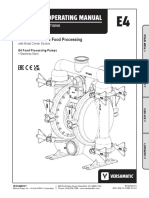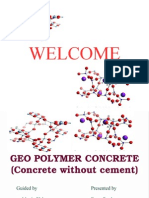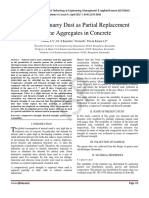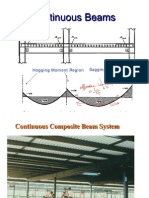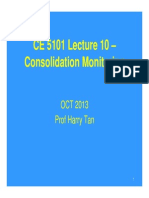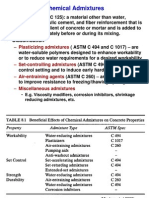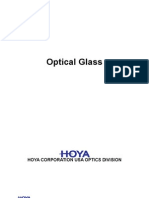0 ratings0% found this document useful (0 votes)
358 views2 Cement Hydration
2 Cement Hydration
Uploaded by
Melinda Gordon1. The main cement compounds hydrate through reactions with water to form hydration products including calcium silicate hydrate (C-S-H) and calcium hydroxide (CH).
2. Tricalcium aluminate (C3A) reacts rapidly at early ages to form ettringite, but ettringite may later transform to monosulphoaluminate if sulfate is consumed.
3. Hydration rates are highest for C3A, followed by C3S, C4AF, and C2S. Hydration generates heat over time and progresses through various stages before reaching a steady state.
Copyright:
© All Rights Reserved
Available Formats
Download as PDF, TXT or read online from Scribd
2 Cement Hydration
2 Cement Hydration
Uploaded by
Melinda Gordon0 ratings0% found this document useful (0 votes)
358 views50 pages1. The main cement compounds hydrate through reactions with water to form hydration products including calcium silicate hydrate (C-S-H) and calcium hydroxide (CH).
2. Tricalcium aluminate (C3A) reacts rapidly at early ages to form ettringite, but ettringite may later transform to monosulphoaluminate if sulfate is consumed.
3. Hydration rates are highest for C3A, followed by C3S, C4AF, and C2S. Hydration generates heat over time and progresses through various stages before reaching a steady state.
Original Description:
S. Mindess, J.F. Young, and D. Darwin, Concrete, Prentice Hall
Copyright
© © All Rights Reserved
Available Formats
PDF, TXT or read online from Scribd
Share this document
Did you find this document useful?
Is this content inappropriate?
1. The main cement compounds hydrate through reactions with water to form hydration products including calcium silicate hydrate (C-S-H) and calcium hydroxide (CH).
2. Tricalcium aluminate (C3A) reacts rapidly at early ages to form ettringite, but ettringite may later transform to monosulphoaluminate if sulfate is consumed.
3. Hydration rates are highest for C3A, followed by C3S, C4AF, and C2S. Hydration generates heat over time and progresses through various stages before reaching a steady state.
Copyright:
© All Rights Reserved
Available Formats
Download as PDF, TXT or read online from Scribd
Download as pdf or txt
0 ratings0% found this document useful (0 votes)
358 views50 pages2 Cement Hydration
2 Cement Hydration
Uploaded by
Melinda Gordon1. The main cement compounds hydrate through reactions with water to form hydration products including calcium silicate hydrate (C-S-H) and calcium hydroxide (CH).
2. Tricalcium aluminate (C3A) reacts rapidly at early ages to form ettringite, but ettringite may later transform to monosulphoaluminate if sulfate is consumed.
3. Hydration rates are highest for C3A, followed by C3S, C4AF, and C2S. Hydration generates heat over time and progresses through various stages before reaching a steady state.
Copyright:
© All Rights Reserved
Available Formats
Download as PDF, TXT or read online from Scribd
Download as pdf or txt
You are on page 1of 50
At a glance
Powered by AI
The key takeaways are the hydration of cement compounds, hydration products formed, and the rate of heat evolution during cement hydration.
The main cement compounds discussed are tricalcium silicate (C3S), tricalcium aluminate (C3A), tetracalcium aluminoferrite (C4AF), and dicalcium silicate (C2S).
The main hydration products formed from cement compounds are calcium silicate hydrate (C-S-H gel), calcium hydroxide (CH), and ettringite.
Hydration of Pure Cement Compounds
Hydration - reaction with water
Reaction products formed hydration products
Calcium silicates
100 + 21 99 22
Note: Difference in mass of water for hydration, products C-S-H and CH
100 + 24 75 49
Tricalcium Aluminate (C
3
A)
Primary initial reaction
(AFt)
Ettringite (Aft) is a stable hydration product only while
there is an ample supply of sulfate
(Intergrind gypsum with clinker to avoid flash set)
(No measured expansion after 2 days max. SO
3
)
(Unstable at temperatures > 70
O
C potential DEF)
If the sulfate is consumed before C
3
A has completely
hydrated
monosulphoaluminate
(Afm)
H
S C A
C
32 3
3
H
S C A
C
12 3
Hydration of Pure Compounds
Ferrite Phase C
4
AF
Forms similar hydration products to C
3
A, but less
reactive
Reactions are slower and involves less heat
Changes in the composition of ferrite phase affect the
rate of hydration
Fe |, hydration becomes slower
Reactions
Hydration Products
Precipitation of
CH and ettringite
at early time
after ~2 hrs, CSH
formed
6 hrs 1 day,
rapid increase of
CH, CSH, and
ettringite
After ~2 days,
ettringite
monosulpho-
aluminate
(Locher & Richartz 1976)
Hydration Rate
Example of relative rate
of hydration of main
potential compounds
C
3
A fast early hydration
(within 1st minute) but
small amount of hydrates
High heat generation over
next few days (< 100 h)
Hydration of C
3
S
generates Ca(OH)
2
(potential for pozzolanic
reaction with SCMs, e.g.
fly ash, ggbs, silica fume)
Hewlett , Ed., 1998
Notes
Gypsum is important to avoid flash set; but if it is too
much, affect setting and hardening, also affect long-
term volume stability as ettringite has high volume that
can cause expansion and cracking if formed at later
age.
The amount required increases with C
3
A content.
Limit: specified in standards, e.g. SS EN 197-1, Table 3
C
3
A is undesirable as it contributes
little to strength except at early
stage; but it is useful to reduce
production temperature of cement
clinker.
(Mindess et al 2003)
Hydration of Portland Cement
Assumption: the cement compounds hydrate
independently
Compound interactions
C
3
A & C
4
AF both compete for sulfate ions
It is suggested that gypsum accelerates C
3
S hydration
Increasing SO
3
may reduce rate of heat evolution and
total hear evolved at early age, but not after 28 days
(Lawrence in Hewlett, 1998)
Kinetics
The rate of hydration during the first few days
C
3
A > C
3
S > C
4
AF > C
2
S
Rate of heat evolution
(Mindess et al. 2003)
Stage 1 dissolution Stage 2 induction (dormant)
Stage 3 Acceleration Stage 4 Deceleration
Stage 5 - Steady
Determine
initial setting
Determine final setting
& initial hardening
Hydration Heat Evolution
Stage 6 onwards hydration rate depends diffusion rate of
water and ions of hydration product (solid state diffusion)
Hewlett, Ed., 1998
Heat of Hydration
Heat of hydration in J/g of a typical cement
H
3 days
= 240 C
3
S + 50 C
2
S + 880 C
3
A + 290 C
4
AF
H
1 year
= 490 C
3
S + 225 C
2
S + 1160 C
3
A + 375 C
4
AF
Quantities of C
3
S, C
2
S, and so on are expressed as weight fraction
of the cement (potential compounds)
C
3
S (502 J/g), C
2
S (260 J/g), C
3
A (1160 J/g), C
4
AF (420 J/g)
Temperature rise due to heat of hydration under
adiabatic condition is ~12-14
o
C per 100 kg of OPC
AT = (M
c
. H) / (M
c
. S
c
+ M
a
. S
a
+ M
w
. S
w
)
Where
H = heat of hydration (increases with degree of hydration -time)
M = mass ( c-cement, a-aggregate, w-water)
S = specific heat (c = 0.88 J/g
o
C, a = 0.75 J/g
o
C, w = 4.18 J/g
o
C)
Concrete: c = 300-500, w = 140-180 , aggregate = 1600-1800 (kg/m
3
)
Heat of Hydration
ASTM Type l = CEM l (strength class 42.5)
ASTM Type III ~ CEM l (strength class 52.5)
ASTM Type IV ~ CEM l (strength class 32.5)
Peak temperature in thick sections , e.g. Pile caps and
raft foundations with least dimension 2 m occurs at
around 3 days (one dimension heat lost)
Neville, 1995, Ref. 1.30, Lerch & Ford, 1948)
(Note: Temperature Effect)
C-S-H
Compositional variation
C/S = 1.5 - 2.0, depends on age of the paste, curing
temperature, w/c, impurities
Varying water content, water in C-S-H exists in several different
states
Physical behavior
Amorphous, poor crystalline materials
Extremely small irregular particles in the size range of colloidal
matter (< 1m)
High surface area ~400 m
2
/g
Develop at the surface of calcium silicate, forms a coating
covering the grain, thickness of the hydrate layer increases
and forms a barrier further hydration is controlled by
diffusion of water in and ions out through the barrier
Model of C S - H structure
Layered structure
C-S-H
bread calcium silicate
sheets
filling Ca
++
, H
2
O
- Sheets are distorted
and randomly arranged.
- Space between the
calcium silicate sheets
is the intrinsic porosity:
I interlayer pores
M- micro pores
P isolated capillary pores
Clay C-S-H
(Mindess 2003)
Model of C S - H structure
Source: Young et al, 1998
Estimated Properties & Influence of C-S-H
Source: Young et al, 1998
C-S-H
Model of CS-H structure and water held in C-S-H
In capillary pores (P), menisci are created as the pores
are filled or emptied (high mass loss, low shrinkage)
In micropores (M), the adjoining surfaces are so close
together that water cannot form menisci, and
consequently has different behavior from bulk water.
Water in M acts to keep the layers apart by exerting
disjoining pressure.
The disjoining pressure depends on RH and disappear
below 50% RH (high shrinkage)
In interlayer pores (I), water are structurally associated
with solid
Hydroxyl water in solid lattice
No sharp distinction between different forms of water
As water is removed from C-S-H, rearrangement of
particles is possible.
Calcium Hydroxide (CH)
Well crystallized material with definite stoichiometry
In voids or cracks: Hexagonal tabular morphology
Strong alkaline, in solution gives a pH>12, responsible for the
protection of steel from corrosion in reinforced concrete
Calcium Sulphoaluminates
Ettringite
Hexagonal crystals in the form of needles, typically 10x0.5
m
Often found in voids or cracks in mature concrete
Monosulphoaluminate
Clusters or rosettes of irregular plates when first
formed
Grow into well-developed, but very thin, hexagonal plates
Degree of crystallinity is decreased to some extent due to
impurities
monosulphoaluminate
CH (striated)
ettringite
(Mindess 2003)
Note: For Information ONLY
Properties of the Hydration Products (Mindess 2003)
Microstructure of Hydrated Cement Paste
(a) Water separates
cement grains
(b-d) solid hydration
products form a
continuous matrix
and bind the
residual cement
grains together.
This happens
because the
hydration products
occupy a greater
volume than the
original cement
compounds due to
their lower specific
gravity (~2.0 vs 3.2)
CH
(Mindess 2003)
Microstructure of Hydrated Cement Paste
C-S-H
Occupy > 50% volume of hydrated paste
Two forms of C-S-H
Early product C-S-H (groundmass & undesignated product)
Grows out from the particle surface into the surrounding
water-filled space in the form of low density arrangement of
thin sheets (outer product from surface of cement grain)
Higher micro porosity
Contains a high level of impurities (Al, SO
4
, K, Na)
Later product C-S-H (inner product)
Denser coating around the hydrating cement grains
The coating forms diffusion barrier during later hydration,
thicken with time, growing inwards & outwards
The coating maintains the shape of original grains
Less impurities, more resistant to physical change on drying
The proportion | as hydration | or the w/c +
Fractured surface
< 3 days
Polished surface
28-day old paste
High degree of complexity
Unhydrated
cement particle
Later CSH
product
Early CSH
product
(Darwin 1994)
Ettringite needles
Interface between early & later CSH
indicate cement grain boundary
Microstructure of Hydrated Cement Paste
Calcium hydroxide
Occupy ~20-25% of the pastes solid volume
In Stage 3 of C
3
S hydration, many CH crystals nucleate
and grow within the capillary pore space
CH will only grow where free space is available
Morphology vary, particularly affected by admixtures and
by temperature of hydration
Calcium sulphoaluminates
Occupy only ~10-15% by solid volume
Play a minor role in the microstructure (although not
necessarily in properties)
Both ettringite and monosulphoaluminate are well
dispersed throughout the paste
Microstructure of Hydrated Cement Paste
Unhydrated residue of cement grains
may persist even in well hydrated cements
Porosity
Classification (Mindess 2003)
Enormous range of pore sizes
Water that occupies the pores plays many different roles
Microstructure of Hydrated Cement Paste
Mehta & Monteiro, 1997
Note: Fine aggregates (> 150 m and < 4 mm)
Coarse aggregates (> 4 mm and < 150 mm)
Microstructure of Hydrated Cement Paste
Porosity - Classification
Capillary pores remnants of water filled space that exists
between the partially hydrated cement grains
Gel pores regarded as an intrinsic part of the C-S-H (cannot
be resolved by SEM), (include small capillary pores)
Capillary pore system is the interconnected network of pores
through which bulk water flow & ion diffusion occur easily
Porosity - Measurements
Mercury intrusion porosimetry
Forcing mercury into pore system by applying external
pressure, pressure required is inversely proportional to
the pore radius
Give better appreciation of capillary pore system
Physical adsorption of gases
Pores are filled by a condensed vapor (gas) through
capillary condensation
Give better measure of gel-pore system
(Medium capillary pores)
(small capillary pores)
{
{
Capillary
pores
Gel pores
Mindess ,2003
Note: Shrinkage and creep both lead to change in surface energy of CSH,
fundamentally related to thermodynamics of gel water
Microstructure of Hydrated Cement Paste (HCP)
Pore solution
Fluid contained in capillary pores is not pure water, but
an ionic solution that is in equilibrium with hydrated paste
inde
In low alkali cement, pH ~ 13
In high alkali cements, pH > 13.5
(S. Diamond, Figure 4.11,
Mindess et al, 2003 )
Note: Role of alkalis in ASR & corrosion passivation in concrete
Note:
Time (> 3 days) for
sufficient amount
of CH to activate
pozzolans
Interfacial Transition Zone
Microstructure of HCP is highly modified in the vicinity of
embedded materials: aggregates, fibers, and reinforcing steel
The modified volume is called interfacial transition zone (ITZ)
Common features of ITZ
Increased porosity
Reduction of unhydrated cement
Higher w/c due to the wall effect and localized bleeding
Within the free space close to the surface, crystals of CH or
ettringite can readily form, CH predominates and often highly
oriented
Thickness of ITZ: ~20-40 m
vary depends on the size, shape, and volume of aggregate, w/c,
mixing and placing procedures
due to wall effect
Interfacial transition zone
ITZ plays an important role
in mechanical properties
and permeability
Recent views:
Potential weakness for crack
initiation in concrete
May be modified by pozzolanic
reaction products and/or nano
particles
Difficulties in determining ITZ
properties due to its small
thickness and changing with
distance from particle surface
Mindess et al. 2003
Volume changes during hydration
All cement hydration products have lower specific
gravities than the cement compounds
Hydration reaction is accompanied by an increase in
solid volume and decrease in porosity.
Expansive reactions
CH grows around solid particles or stops growing when it
meets obstacles. The same is true of C-S-H. Thus, the
hydration of calcium silicates is not accompanied by increase
in the total volume of paste. If original water occupied space is
filled, hydration will cease.
Bulk expansion occurs when ettringite is formed after cement
paste is hardened. If space is limited, ettringite crystals may
develop crystal growth pressures.
Early age, plenty space for ettringite to grow, no problem
Calculation of volume change
Equations are empirical, derived from experimental data
The hydrated cement includes all hydration products, CH, C-S-H, and
sulphoaluminates
Evaporable water lost under D-drying or oven drying condition
(include water in capillary and gel pores, and water in sulphaluminates)
Non-evaporable water - lost from D-drying to 1000
o
C (measures water
chemically combined in hydration products)
Non-evaporable water
, o = degree of hydration
Evaporable water associated with hydration products
w
g
: gel water (C-S-H) + water
in in calcium sulphoaluminates
Total volume of hydration products
Gel porosity
constant for all normally
hydrated cements
Calculation of volume change
Capillary pore volume
Volume occupied by unhydrated cement
v
c
specific volume of cement, (1/specific gravity) = 0.32
Original volume of the paste
Capillary porosity
Gel/space ratio
Volume relationships among constituents of hydrated cement pastes
w/c = 0.5
o = 1.0
Mindess et al. 2003
Full Hydration
POSSIBLE in practice?
Calculation of Volume Change
Minimum w/c ratio
At low w/c ratios, there is insufficient space for the
hydration products to form so that complete hydration is
not possible. The minimum w/c that can be used and still
ensure complete hydration can be determined from
Set V
c
= 0, and o=1, the minimum w/c = 0.36
However, the hydration products must be formed with
the gel pores saturated. Thus, water required for
complete hydration is
For complete hydration (o=1), the w/c should not be <0.42
0.24o 0.18o
Volume Relationship
For example 100 g of cement at o = 1 (fully hydrated)
V
hc
= 100/3.15 = 32 cm
3
(density 1 g/cm
3
= 1000 kg/m
3
)
w
n
= 0.24 o g/g of cement, V
wn
= 24 cm
3
w
g
= 0.18o g/g of cement, V
wg
= 18 cm
3
V
hp
= 0.68o cm
3
/g of cement = 68 cm
3
V
hc
+ V
wn
< V
hp
< V
hc
+ V
wn
+ V
wg
32 + 24 68 32 + 24 + 18
(56) (74)
[vol. of reactants]< [vol. of product] < [vol. of components]
Note: V
hc
, space for inner product. Outer product in space
provided by water (w/c 0.42 for full hydration)
Volume Relationship
For example 100 g of cement at o = 1 (fully hydrated)
V
hc
= 100/3.15 = 32 cm
3
(density 1 g/cm
3
= 1000 kg/m
3
)
w
n
= 0.24 o g/g of cement, V
wn
= 24 cm
3
w
g
= 0.18o g/g of cement, V
wg
= 18 cm
3
V
hp
= 0.68o cm
3
/g of cement = 68 cm
3
V
hc
+ V
wn
< V
hp
< V
hc
+ V
wn
+ V
wg
32 + 24 68 32 + 24 + 18
(56) < (74)
[vol. of reactants]< [vol. of product] < [vol. of components]
Note: V
hp
< volume of components , difference in volume to
be filled from ingress of external water (curing) otherwise by
some capillary water forms vapour (vapour pressure < 1, RH
< 100%) e.g. sealed specimen or external RH < 100%
Volume Relationship
Non-evaporable water
Evaporable water in hydrated products
Volume of hydrated products
Capillary porosity
Gel/space ratio
Except for X, all are linearly proportional to degree of hydration, o
Consider the cases at o = 0.5 (50% hydration) for w/c of 0.36, 0.42 and 0.50
Factors Leading to Cessation of Hydration
Environmental factors:
Temperature lower than ( 10
O
C) freezing of pore fluid
Lack of water for hydration, e.g. w/c < 0.42, o < 1.0
Lowing vapour pressure in capillary pores, e.g. sealed
specimen, no ingress of water (curing)
Vapour pressure < 0.8: hydration rate is low
Vapour pressure < 0.3: hydration rate is negligible
[Powers, 1947 Ref. 7.36 in Neville, 1995, Fig. 7.1]
Physical factors:
Lack of space for hydration products, e.g. w/c < 0.36
Large grain size cement particles (> 40 m in diameter)
In practice, common curing period is 7 days, o < 0.6 to 0.7
w/c 0.2 to 0.3 for high strength concrete [What value is o?]
Environmental Factor
Hydration rate highest when capillary
pores are saturated, i.e. vapour
pressure of 1.0 (RH 100%)
Below vapour pressure of 0.8 (RH 80%)
hydration is low
Below vapour pressure of 0.3 (RH 30%)
hydration is negligible
Note: Tropical hot wet climate, range
of ambient RH between 60% (afternoon)
and over 80% (night)
Air-conditioning may bring RH to 30%
Source: Properties of Concrete, A.M. Neville, 4
th
Ed. 1995, Pitman
Powers, T.C., A discussion of cement hydration in relation to curing of concrete, Proc. Highw. Res. Bd, 27, 1947
Fig. 7.1
Schematic Representation of Single Cement Grain
Modified from Williamson, 1970
Comparison of ASTM and BS-EN Standards
ASTM BS-EN
Portland
cement
C 150 Spec for Portland
cements
197-1: 2000 (SS EN 197-1: 2008)
CEM I Portland cement
[197-1: 2011]
Blended
cements
C 595 Spec for blended
hydraulic cements
197-1: 2000 (SS EN 197-1: 2008)
CEM II Portland comp. cem
CEM III blastfurnace cem
CEM IV pozzolanic cem
CEM V composite cem
C 1157 Performance Spec
for blended hydraulic
cements
Mineral
admixtures
C 618 Spec for coal fly ash
and raw or calcined natural
pozzolans for use in concrete
450-1: 2005
Fly ash for concrete Definition,
spec, and conformity criteria
C 989 Spec for GGBFS for
use in concrete and mortars
15167-1: 2006 (SS EN 15167: 2008)
Ground granulated blast furnace
slag for use in concrete, mortars,
and grouts
C 1240 Spec for silica fume
used in cementitious
mixtures
13263-1: 2005
Silica fume for concrete
Portland cement
CEM I K = 95 to 100%, MAC = 0 to 5%
Portland-fly ash cement (MAC = 0 to 5%)
CEM II/A-V: K = 80 to 94%, V = 6 to 20%
CEM II/B-V: K = 65 to 79%, V = 21 to 35%
Portland-silica fume (MAC = 0 to 5%)
CEM II/A-D: K = 90 to 94%, D = 6 to 10%
Clinker: K, Blastfurnace slag: S
Silica fume: D, Fly ash: V (siliceous)
Blastfurnace cement (MAC = 0 to 5%)
CEM III/A: K = 35 to 64%, S = 36 to 65%
CEM III/B: K = 20 to 34%, S = 66 to 80%
CEM III/C: K = 5 to 19%, S = 81 to 90%
No change in Table 1 of BS EN 197-1: 2011
Specification for Constituent Materials Cement
Revision of BS EN 197-1: 2011
Combining EN 197-1 and EN 197-4 and addition of sulfate resisting
classes of cement (superseding EN 197-1 and EN 197-4)
SS EN 197-1: 2008 to be revised as per BS EN 197-1: 2011
Sulfate resisting cements 3 main groups:
Sulfate resisting Portland cement
CEM I-SR 0, sulfate resisting Portland cement (C
3
A content of clinker = 0%)
CEM I-SR 3, sulfate resisting Portland cement (C
3
A content of clinker 3%)
CEM I-SR 5, sulfate resisting Portland cement (C
3
A content of clinker 5%)
Sulfate resisting blast furnace cement (no requirement on C
3
A content of clinker)
CEM III/B-SR, sulfate resisting blast furnace cement
CEM III/C-SR, sulfate resisting blast furnace cement
Sulfate resisting pozzolanic cement (C
3
A content of clinker 9%)
CEM IV/B-SR, sulfate resisting blast furnace cement
CEM IV/C-SR, sulfate resisting blast furnace cement
Specification for Constituent Materials Cement
Revision of BS EN 197-1: 2011
Table 2 Seven products in sulfate resisting common cements
Main
types
Notation of the seven
products
(types of common
sulfate resisting
cements)
Composition (percentage by mass)
Main constituents Minor
additional
constituents
Clinker
K
Blast
furnace
slag
S
Pozzolana
natural
P
Siliceous
fly ash
V
CEM
I
Sulfate
resisting
Portland
cement
CEM I-SR 0
CEM I-SR 3
CEM I-SR 5
95 - 100 - - - 0 - 5
CEM
III
Sulfate
resisting
blast
furnace
cement
CEM III/B
- SR
20 - 34 66 - 80 - - 0 - 5
CEM III/C
- SR
5 -19 81 - 95 - - 0 - 5
CEM
IV
Sulfate
resisting
pozzolanic
cement*
CEM IV/A
- SR
65 - 79 21 - 35 0 - 5
CEM IV/B
- SR
45 -64 36 - 65 0 - 5
* Main constituents other than clinker shall be declared by designation of cement (P or V)
Specification for Constituent Materials Cement
Revision of BS EN 197-1: 2011
Table 3 Mechanical and physical properties as characteristic values
Strength
class
Compressive strength (MPa) Initial setting
time
Soundness
(expansion
Early strength Standard strength
2 days 7 days 28 days min mm
32,5 L
a
- 12
32,5 52,5 75
10
32,5 N - 16
32,5 R 10 -
42,5 L
a
- 16
42,5 62,5 60 42,5 N 10
42,5 R 20
52,5 L
a
10
52,5 - 45 52,5 N 20
52,5 R 30
a
Strength only defined for CEM III cements
NOTE: CEM III cements are distinct low early strength blastfurnace cements
VICAT APPARATUS EN 196-3: 2005
Standard Consistence:
Water content for 500 kg cement when
distance between plunger (Figure 1 c)
and base-plate is (6 2) mm (to the
nearest 0,5%)
Initial Setting Time:
The elapsed time, measured from zero to
time at which distance between needle
(Figure 1 d) and the base-plate is (6 3)
mm (to the nearest 5 min.)
Final Setting Time:
The elapsed time, measured from zero to
that at which the needle (Figure 1 e) first
penetrates only 0,5 mm into the
specimen (to the nearest 15 min.)
Note: No requirement in BS EN 197-1
Chemical Requirements (BS-EN 197-1: 2000)
Note:
SO
3
limit for
different
strength class
Note:
Higher limit
for CEM II/B-T
& CEM lll/C
Identical with
Table 4 of BS
EN 197-1:
2010
Compressive Strength Determination
Cartoon on Concrete
Source: IEM Bulleting
You might also like
- e4mdlAsmFP Rev1122Document16 pagese4mdlAsmFP Rev1122Pkk Siam Rayong co-saleNo ratings yet
- IESAV - 2b. Design of Prestressed Transfer PlateDocument39 pagesIESAV - 2b. Design of Prestressed Transfer PlateMelinda GordonNo ratings yet
- Specification of ConcreteDocument64 pagesSpecification of ConcreteMelinda Gordon80% (5)
- Ce5805 (0) IntroDocument14 pagesCe5805 (0) IntroMelinda GordonNo ratings yet
- False Set and Flash Set and CEMENTDocument31 pagesFalse Set and Flash Set and CEMENTk_981966368No ratings yet
- Seminar On GGBS & Silica FumeDocument10 pagesSeminar On GGBS & Silica FumeawasarevinayakNo ratings yet
- Silica Fume and Fly AshDocument14 pagesSilica Fume and Fly AshGeetesh MakadiaNo ratings yet
- 4 Heat of Hydration PDFDocument48 pages4 Heat of Hydration PDFDani Abdurrahman MNo ratings yet
- Cement PPT ArunDocument10 pagesCement PPT ArunAbhishek SharmaNo ratings yet
- Is 2645 (2003) - Integral Waterproofing Compounds For Cement Mortar and Concrete - SpecificationDocument16 pagesIs 2645 (2003) - Integral Waterproofing Compounds For Cement Mortar and Concrete - SpecificationMeet ChokshiNo ratings yet
- 1 Cement-1Document61 pages1 Cement-1Nikhil Tanwar100% (1)
- CEMENTDocument77 pagesCEMENTLeecel CalugayNo ratings yet
- Lecture #4&5 Time Setting and Soundness of Portland CementDocument28 pagesLecture #4&5 Time Setting and Soundness of Portland CementRome Lauren JavierNo ratings yet
- Green ConcreteDocument22 pagesGreen ConcreteQseem Khan100% (1)
- Lecture - Concrete Durability1Document217 pagesLecture - Concrete Durability1Colin Booth100% (1)
- Methods To Determine Heat of Hydration of CementDocument5 pagesMethods To Determine Heat of Hydration of Cementk_981966368No ratings yet
- Unit 1 Cement and ConcreteDocument130 pagesUnit 1 Cement and Concretehamshini100% (1)
- F-Admixture Project ThesisDocument61 pagesF-Admixture Project Thesismuhammad najeebNo ratings yet
- White GRC - Glass Fibar Reinforced ConcreteDocument4 pagesWhite GRC - Glass Fibar Reinforced ConcreteProjNo ratings yet
- ABOUT CEMENT & ITS USE - What Is Cement?Document5 pagesABOUT CEMENT & ITS USE - What Is Cement?Prasanjeet DebNo ratings yet
- What Is The Difference Between Slag and CementDocument2 pagesWhat Is The Difference Between Slag and Cementfaw03No ratings yet
- GeopolymerDocument20 pagesGeopolymerAhmed TahaNo ratings yet
- 10 XI November 2022Document12 pages10 XI November 2022IJRASETPublicationsNo ratings yet
- Chemical Admixtures-Chemistry, Applications and Their Impact On Concrete Microstructure and DurabilityDocument19 pagesChemical Admixtures-Chemistry, Applications and Their Impact On Concrete Microstructure and Durabilityjaysern7100% (1)
- Soundness Test On Cement by Le - Chatelier MethodDocument4 pagesSoundness Test On Cement by Le - Chatelier MethodShahrukh NiazNo ratings yet
- Specific Gravity of CementDocument5 pagesSpecific Gravity of CementJa Phe TiNo ratings yet
- Geo Polymer ConcreteDocument17 pagesGeo Polymer ConcreteAshutosh RungtaNo ratings yet
- Concrete Technology 2Document12 pagesConcrete Technology 2ReemALMousawi100% (1)
- Polymer ConcreteDocument30 pagesPolymer Concretejoshua humirang100% (1)
- Mortar Testing: What Is A MORTAR (MASONRY) ?Document4 pagesMortar Testing: What Is A MORTAR (MASONRY) ?Kelvin Loria100% (1)
- Alkali Activated ConcreteDocument9 pagesAlkali Activated ConcreteKofi AboraNo ratings yet
- Notes of CementDocument8 pagesNotes of CementNEHALJAIN15No ratings yet
- Durability Design PDFDocument46 pagesDurability Design PDFMahadev SastryNo ratings yet
- By Yuvraj KocharDocument32 pagesBy Yuvraj KocharShivangi KocharNo ratings yet
- Nano ConcreteDocument12 pagesNano ConcreteDvorah KahnNo ratings yet
- What Factors Affects Air Content of ConcreteDocument2 pagesWhat Factors Affects Air Content of ConcreteKalindaMadusankaDasanayakaNo ratings yet
- Cement Technical Reference GuideDocument22 pagesCement Technical Reference GuideroxannemansNo ratings yet
- Studies On Quarry Dust As Partial Replacement of Fine Aggregates in ConcreteDocument3 pagesStudies On Quarry Dust As Partial Replacement of Fine Aggregates in ConcreteEditor IJLTEMASNo ratings yet
- Application of Sustainable Cement Alternatives in ConcreteDocument6 pagesApplication of Sustainable Cement Alternatives in ConcreteCARLOS ALTAMIRANO GUPIOCNo ratings yet
- Use of Chemical and Mineral Admixtures in ConcreteDocument17 pagesUse of Chemical and Mineral Admixtures in ConcreteManmohan Sharma67% (3)
- Properties of Cement - Physical & Chemical - Civil EngineeringDocument10 pagesProperties of Cement - Physical & Chemical - Civil EngineeringMuhammad YaseenNo ratings yet
- Air Content in Concrete - Concrete Air Test - The Concrete NetworkDocument4 pagesAir Content in Concrete - Concrete Air Test - The Concrete NetworkPritha DasNo ratings yet
- Hydration of Cement-1Document23 pagesHydration of Cement-1atul_kolhe100% (1)
- Types of CementDocument22 pagesTypes of CementVaishaliNo ratings yet
- Durability of ConcreteDocument33 pagesDurability of Concreteabdulwahab11No ratings yet
- Silica FumeDocument24 pagesSilica FumeRanjith Balu Pkm100% (1)
- Presented by - Aniket Ghosh Dastidar Construction Engg. 4 Year Jadavpur UniversityDocument20 pagesPresented by - Aniket Ghosh Dastidar Construction Engg. 4 Year Jadavpur UniversitySaurabh AgrawalNo ratings yet
- Report Floating Concrete...Document5 pagesReport Floating Concrete...AnkitNo ratings yet
- Fineness of Cement by Blaines Air Permeability MethodDocument6 pagesFineness of Cement by Blaines Air Permeability MethodJa Phe TiNo ratings yet
- Transparent ConcreteDocument15 pagesTransparent Concreteanshudubeymath1No ratings yet
- Influence of SO3 On The Hydration HeatDocument10 pagesInfluence of SO3 On The Hydration HeatPaknubkNo ratings yet
- Constituent MaterialsDocument69 pagesConstituent MaterialsTejas Doshi100% (1)
- SeminarDocument21 pagesSeminarsoukhya100% (1)
- Admixtures in ConcreteDocument60 pagesAdmixtures in ConcreteTeo Peng Keat100% (1)
- Literature Survey On Geopolymer Concretes and A Research Plan in Indian ContextDocument13 pagesLiterature Survey On Geopolymer Concretes and A Research Plan in Indian ContextVikas Biradar100% (1)
- 2 Types of Supplementary MaterialsDocument52 pages2 Types of Supplementary MaterialsHarpreet Singh100% (1)
- Practical Questionall About ConcreteDocument18 pagesPractical Questionall About ConcreteSher John TombocNo ratings yet
- Lightweight Aggregate ConcreteDocument36 pagesLightweight Aggregate Concretegopierode4No ratings yet
- Cracks in ConcreteDocument45 pagesCracks in ConcreteRanjeet SinghNo ratings yet
- Chemical Analysis and Percent CementDocument8 pagesChemical Analysis and Percent CementValeria PerlazaNo ratings yet
- Creep in ConcreteDocument26 pagesCreep in ConcreteheminNo ratings yet
- Properties and Testing of CementDocument51 pagesProperties and Testing of Cementarnob2223007No ratings yet
- 2 - Cement HydrationDocument40 pages2 - Cement Hydrationscpn5nnsprNo ratings yet
- Concrete Materials: CIEN 30023 S.Y. 2ND SEM 2019-2020Document49 pagesConcrete Materials: CIEN 30023 S.Y. 2ND SEM 2019-2020Mhervin Bisis100% (1)
- TCC15 Resistance of Retaining MembersDocument9 pagesTCC15 Resistance of Retaining MembersMelinda GordonNo ratings yet
- TCC54 Circular Column DesignDocument93 pagesTCC54 Circular Column DesignMelinda Gordon100% (1)
- TCC33 Flat Slabs (A & D)Document37 pagesTCC33 Flat Slabs (A & D)Melinda GordonNo ratings yet
- Circular Fire CodeDocument2 pagesCircular Fire CodeMelinda GordonNo ratings yet
- TCC11 Element DesignDocument8 pagesTCC11 Element DesignMelinda GordonNo ratings yet
- 11 Continuous BeamsDocument55 pages11 Continuous BeamsMelinda GordonNo ratings yet
- Lecture 7Document193 pagesLecture 7Melinda GordonNo ratings yet
- CE5101 Lecture 10 - Consolidation Monitoring Using Hyperbolic Method (OCT 2013) (Compatibility Mode)Document30 pagesCE5101 Lecture 10 - Consolidation Monitoring Using Hyperbolic Method (OCT 2013) (Compatibility Mode)Melinda GordonNo ratings yet
- Selection of Concrete CompositionDocument62 pagesSelection of Concrete CompositionMelinda GordonNo ratings yet
- Fresh ConcreteDocument60 pagesFresh ConcreteMelinda GordonNo ratings yet
- 2 Local Buckling and Section Classification - 2011Document21 pages2 Local Buckling and Section Classification - 2011Melinda GordonNo ratings yet
- 4 Chemical AdmixturesDocument59 pages4 Chemical AdmixturesMelinda Gordon100% (1)
- Ce5112 Chap1Document103 pagesCe5112 Chap1Melinda GordonNo ratings yet
- Bored Tunnels Design and Construction: WEN DazhiDocument80 pagesBored Tunnels Design and Construction: WEN DazhiMelinda GordonNo ratings yet
- One Pass and Two Pass Tunnel LiningDocument16 pagesOne Pass and Two Pass Tunnel LiningGelai Santos100% (2)
- Lynx PublicationDocument11 pagesLynx PublicationSwarnendraNo ratings yet
- Covelent BondingDocument4 pagesCovelent BondingMBOTAKE LawsonNo ratings yet
- (BP504, Pharmacognosy & Phytochemistry II, Unit 1Document9 pages(BP504, Pharmacognosy & Phytochemistry II, Unit 1vishu950753No ratings yet
- Optical GlassDocument22 pagesOptical GlassRahul TripathiNo ratings yet
- ws15 4Document5 pagesws15 4Sierra LeeNo ratings yet
- 5540 SurfactantesDocument9 pages5540 SurfactantesCecilia AvilaNo ratings yet
- Chapter 18 (Review)Document5 pagesChapter 18 (Review)emyatthu55No ratings yet
- Redox ReactionsDocument22 pagesRedox ReactionsAbdul RehmanNo ratings yet
- Assigment 1 Engineering Materials BFM 1113: Name: Sharifah Syahira Bte Syed Mohamad Matrix Card: FB10060Document19 pagesAssigment 1 Engineering Materials BFM 1113: Name: Sharifah Syahira Bte Syed Mohamad Matrix Card: FB10060Sharifah Leha100% (1)
- Maglumi 800 SpesifikasiDocument7 pagesMaglumi 800 SpesifikasiCallita Rivera GonzálezNo ratings yet
- Nassar2017 Article PreparationAndEvaluationOfTheMDocument13 pagesNassar2017 Article PreparationAndEvaluationOfTheMCristinaNo ratings yet
- Li 2019 Liquid Phase Catalytic Oxidation ofDocument13 pagesLi 2019 Liquid Phase Catalytic Oxidation ofElisabeta StamateNo ratings yet
- Chemistry VCE ExamDocument24 pagesChemistry VCE ExamFreya AlbrechtNo ratings yet
- Chemistry Exam Questions For Ss2 Senior Secondary SchoolsDocument4 pagesChemistry Exam Questions For Ss2 Senior Secondary SchoolsOKOREMUNo ratings yet
- 8TH Online Preparing Common SaltsDocument4 pages8TH Online Preparing Common Salts20I1190 G-7CNo ratings yet
- XII Chemistry 2023 (Complete Notes) - 1Document201 pagesXII Chemistry 2023 (Complete Notes) - 1anzalabdullatif2004No ratings yet
- C4 Periodic Properties-1Document42 pagesC4 Periodic Properties-1Safia Sa50% (2)
- Xylene: O-Xylene M-Xylene P-XyleneDocument5 pagesXylene: O-Xylene M-Xylene P-Xylenetaha akmalNo ratings yet
- Chemical and Reagent HazardsDocument18 pagesChemical and Reagent Hazardssarcali0% (1)
- Instant download Protein Purification Techniques A Practical Approach Second Edition Simon Roe (Editor) pdf all chapterDocument45 pagesInstant download Protein Purification Techniques A Practical Approach Second Edition Simon Roe (Editor) pdf all chapterghdeerbordat100% (2)
- Sunlight Dishwashing LiquidDocument4 pagesSunlight Dishwashing Liquidisnaeniwalidah8No ratings yet
- Making Soap Using Beeswax and Honey: How Beekeepers Clean Up With Value - Added ProductsDocument30 pagesMaking Soap Using Beeswax and Honey: How Beekeepers Clean Up With Value - Added ProductsJuan VilláNo ratings yet
- Calcia Stabilized ZirconiaDocument3 pagesCalcia Stabilized Zirconiaedwardbloomcer06No ratings yet
- Lemongrass (Cymbopogon) : A Review On Its Structure, Properties, Applications and Recent DevelopmentsDocument23 pagesLemongrass (Cymbopogon) : A Review On Its Structure, Properties, Applications and Recent DevelopmentsAkbar RoebethoNo ratings yet
- 2017 Effect of Grinding Method and Particle Size Distribution On Long Termproperties of Binary and Ternary CementsDocument8 pages2017 Effect of Grinding Method and Particle Size Distribution On Long Termproperties of Binary and Ternary CementsTiago BragaNo ratings yet
- A Level RespirationDocument19 pagesA Level RespirationBWAMBALE HARISONNo ratings yet
- How Do I Prepare A Phosphate Buffer Solution With A Specific PHDocument2 pagesHow Do I Prepare A Phosphate Buffer Solution With A Specific PHjagruthimsNo ratings yet
- Analytical Chmistry Lab 3Document10 pagesAnalytical Chmistry Lab 3Montazer WorkNo ratings yet
- Chap 1Document28 pagesChap 1ALIYAN ALINo ratings yet
